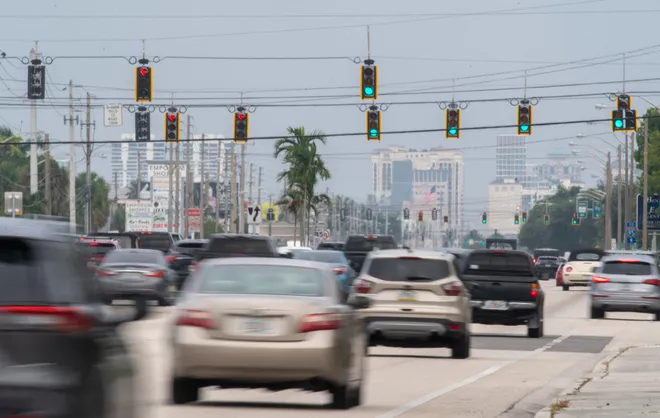Yellow lights are inconsistent and chaotic. Here's why.
The light just turned yellow and you've got a tough decision to make.
Braking doesn't seem right – you're going too fast for a smooth stop. But continuing to drive also doesn't seem right – the light might turn before you reach the intersection.
Experts have a name for this common problem: The dilemma zone. It's just one of the many problems with stoplights that researchers, engineers and the U.S. Department of Transportation want to improve.
"If you see the yellow way ahead of time, you have enough distance to actually come to a safe stop. If you're close to the intersection when the yellow comes, you can safely pass the intersection. But there is a point in between these two where you're in a dilemma: 'Hey, should I go, or should I not go?' And that's the dilemma zone," said Jijo Mathew, a transportation research engineer with the Joint Transportation Research Program at Purdue University.
Unsolved problems like this have prompted researchers, engineers and government officials to keep looking for high and low-tech innovations that can help make intersections safer and more efficient. Recently, artificial intelligence and data from apps like Google Maps have given experts hope that driving can get safer and less frustrating.
Here's what's wrong with traffic lights and what experts say can be done to fix them.
What's the problem with traffic lights?
There's several issues with stoplights in the U.S., according to researchers:
- They can hold up traffic: Inefficient lights make people stop when they don't really have to.
- They can be dangerous: Intersections account for a good portion of traffic fatalities and injuries.
- People hate them: People hate sitting at an intersection with no cross traffic or guessing how long a yellow light will be.
- Many haven't really changed in years: Some behind-the-scenes tech has improved how lights work, but most of the hundreds of thousands of U.S. traffic lights use outdated pre-timed light schedules.
How long will that yellow light last?
The yellow light's dilemma zone is one of the most universal problems. It forces drivers to choose between two dangerous possible risks – being rear ended because of stopping too quickly, or causing a collision by going through an intersection after a light turns red.
Complicating matters: Yellow lights are intentionally different lengths in the U.S.
In most places, traffic engineers strive to give people one second to make a decision after they notice the light has turned yellow. That means they set the amount of time the light stays yellow depending on the posted speed limit and other road condition factors.
The end result is supposed to give you the right amount of time to either brake or continue through safely.
But is one second really enough? Researchers have found a driver's age strongly influences how quickly they react to the light change and whether they choose to stop or go through an intersection.
About one-quarter of vehicle fatalities happen at intersections, according to the Department of Transportation. Intersections also account for roughly half of all injuries.
“In terms of mileage, there’s a lot of mileage on freeways, but many accidents occur at intersections,” said Henry Liu, a civil and environmental engineer who directs the Traffic Lab at the University of Michigan.
POLICE CAR CRASHES:Devastating injuries. Sometimes few consequences.
Ideas from other countries
While the U.S. has neither the best nor the worst traffic signals in the world, Liu said, there are some countries with innovations not yet tried here.
Roundabouts are a more common feature in some European countries, and studies show that when they’re implemented in the U.S., they reduce injuries and fatalities within intersections, Liu said. The traffic circles force drivers to slow down, reducing the chances for serious harm. But they can also be confusing for drivers who aren’t familiar with them, leading to more minor accidents. They also cut down on time waiting for lights to change.
One town has more roundabouts than anywhere else in the U.S.: Carmel, Indiana. There, former seven-term Mayor Jim Brainard ushered in the roundabout network that grew to over 150 since the 1990s, for a population of about 100,000.
In about two dozen countries, but not the U.S., drivers get a warning before green turns to yellow. Giving drivers a warning using a timer system can lead to safer choices, researchers at Oregon State University found.

For some Americans, AI will decide when they stop and go
At some traffic lights, sensors are installed that can detect vehicles and adjust lights according to traffic. In select locations, traffic lights are actually talking directly to each other and to vehicles on the road to coordinate timing. Boston recently launched a partnership with Google’s Green Light program, which uses AI at traffic lights to help reduce emissions, WFXT reported earlier this month.
Pollution on city streets is worse than on open roads, and is worsened by cars accelerating after stopping over and over at red lights, the Green Light program says. The program uses information on traffic trends gleaned from software like Google Maps, which many drivers use to navigate, to make optimized traffic light pattern recommendations with the aim of reducing the stop-and-go and making commutes more efficient.
In Palm Beach County, Florida, officials are also installing smart traffic signals that will use sensors to assess traffic flow and talk to one another to coordinate synchronized lights, the Palm Beach Post, part of the USA TODAY Network, reported.
The government hopes new tech will make for safer roads
Earlier this month the Department of Transportation rolled out its plan to deploy a wireless connectivity technology it hopes will help get the country to zero roadway fatalities.
Connected vehicle technology, called V2X, or vehicle-to-everything, is when vehicles can communicate directly both with each other and with traffic lights using short-range signals. When all the sensor data from connected vehicles is taken together, it paints a pretty accurate picture of where every building, car, bus, pedestrian and emergency vehicle is in relation to each other and a stoplight.
The technology can help not just efficiency, but safety, Liu said. If one car was going to run a red light, all the sensors in cars around it and at the intersections themselves could capture that information and broadcast it to drivers who might not be able to see the light runner.

“I believe V2X technology has great potential to improve safety at these intersections,” Liu said.
As for the yellow light dilemma, Mathew and former co-researcher Howell Li teamed up a few years ago at Purdue University and came up with an invention they said could save lives at intersections. If traffic signals could use data about vehicles' location and trajectory to either extend green lights by brief moments when cars are in the dilemma zone, or change to yellow early when no cars are in the zone, they could cut down on dangerous decision-making.
They set up an experiment in Indiana using communication devices that told traffic signals a car's exact location as it approached an intersection, and found the technology has the potential to reduce red-light running.
"You're going to have to evolve traffic signal controllers in a way that can take and make use of all these new parameters," said Li, owner of LSM Analytics LLC, a transportation data analytics company. "Before, it was a limitation of how we can detect vehicles. Now, that limitation, that ceiling has just pretty much gone away."
Disclaimer: The copyright of this article belongs to the original author. Reposting this article is solely for the purpose of information dissemination and does not constitute any investment advice. If there is any infringement, please contact us immediately. We will make corrections or deletions as necessary. Thank you.
